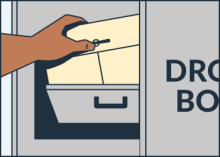Filing your court papers
Where to file
If these are the first papers filed in a case (you're starting the case), first decide which county you need to file in ("venue"), and then you can use Find my court to get information about where to file in that county.
If you're filing a document in a case that’s already been started, file at the same court with the same case number.
How to file
You can always file in person or by mail. In many courts, you can also file online (called e-filing), by fax, or by drop box. You can check on the court's website whether or not it allows e-filing or fax filing.

If you use a dropbox, make sure all the originals and any copies are secured together (with a clip or in an envelope) and that you've included any filing fee or fee waiver if required. If you don't want to have to go back to court to pick up the filed copies, also include a self-addressed stamped envelope with enough postage for the copies to be mailed back to you once the clerk files them.
If you file by mail, include a self-addressed stamped envelope with enough postage so the clerk can mail the copies back to you. Also, include any filing fee or a fee waiver, if required.
What you file
File the originals. Also include any copies you're filing, unless you're efiling or filing by fax. Include any payment or a fee waiver, unless what you're filing doesn't require a fee. Find the court fees.
Who can file
Anyone 18 or over can file the forms. You do not need to personally file them.
If you file yourself, you can fix any errors on the spot if the clerk points them out.
- If you forgot to sign somewhere or did not include a local form, you could sign and fill out the form.
- If you are getting a court date, you may be able to have a say about which court date works best for you.
- If there are fees you don't know about, or your fee waiver is denied, you will be able to fix it or pay the extra fees right away.
- If you have a question about your next steps or need to correct something in your filing, you could go directly to the court's Self-Help Center for help.
Paying filing fees
If you're required to pay a fee, the payment (or a request for a fee waiver) is due when you file the forms papers. If you are not sure if a fee is required, you can check the court fee schedule or ask the clerk. If you asked for a fee waiver, a clerk or judge will decide if you qualify for a fee waiver. You will be asked to pay later if you did not qualify.
Most courts accept cash, credit cards, money orders, cashier’s checks, and personal checks
Make your check out to, “Superior Court of California, County of ______” and write the county name where you will be filing your forms. If you are filing online, you’ll pay by credit card when you file. Contact your court for more information about what type of payments they accept.
Helpful links

